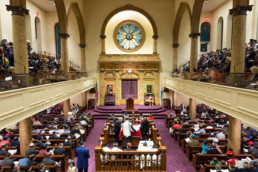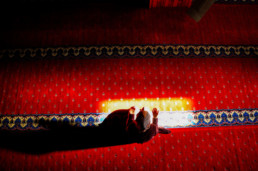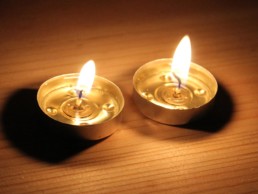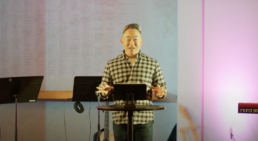The Gospel Music of Abyssinian Baptist Church
Lift every voice and sing
Till earth and heaven ring
The 14-person chorus chanted lyrics from a book called African American Heritage Hymnal as they swayed together in perfect rhythm. Behind the pulpit, the piano, organ, guitar and drum ensemble, dressed in their black Sunday best, joined in as the embodiment of religious devotion.
May we forever stand
True to our God
True to our native land
The Rev. Dr. Calvin O. Butts III introduced the opening hymn on the first Sunday of Black History Month as the celebratory anthem for the African people. His church, Abyssinian Baptist in Harlem, was formed when a handful of African devotees broke away from the predominantly white First Baptist Church more than 200 years ago. On this Sunday, the sanctuary was decorated with traditional African brocade; a testament to the artistic creativity that defined a people.
“We have so much talent in this room,” said the reverend. “This is all a part of our great expression.”
The African American church has been using music to tell its story since its inception. At Abyssinian’s service, gospel music expressed what Bible verses may have not – the resilience and faith of Black America.
Butts led by singing a new song, while the Total Praise ensemble followed his cue, almost as if to represent the spirited Abyssinians themselves.
We have come this far by faith,
Leaning on the Lord,
“Everybody sing to the glory of God,” instructed the Rev. Dr. Raschaad Hoggard, preaching each lyric before the choir joined in. “Now let’s sing with conviction!
Trusting in His holy Word,
He's never failed us yet.
The rows of well-dressed men and women were joined together by the nostalgia of each verse and the spirituality of each word. The song served as its own kind of prayer, with a resounding message of safety in God’s care.
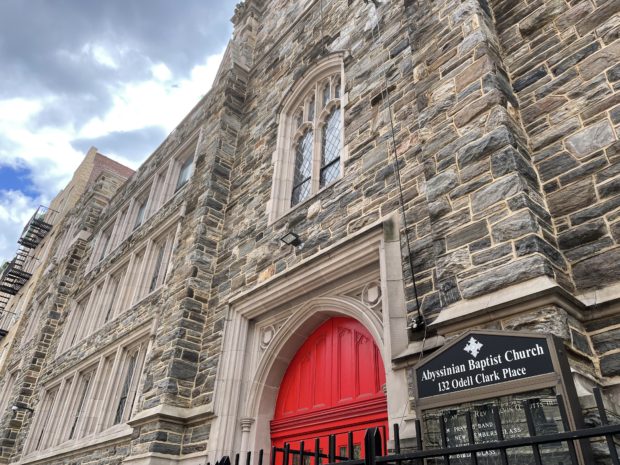
As the choir began their gospel rendition of Happy Birthday for all churchgoers with February birthdays, I saw masked worshippers hugging each other and posing for photographs. It seemed like their warm embrace was to make up for the past two years of isolation, and the music was what brought a familiar sense of community that they had been missing.
The pastor brought everyone back to their pews to start a sermon from Apostles 8:26. In it, he described the kings and queens of Ethiopia who were consistently underestimated, and who served as a lesson of the great successes Black people had found throughout time and oppression.
“The core of our people is our struggle,” he said.
A twinkling piano melody filled the silence between affirmative “mmms” and “Amens.” The long phrases felt deeply meditative, and his hands seemed to glide over the keys as he closed his eyes, entranced with what, or whom, he felt.
He’s got the whole world in His hands.
An operatic soprano performed the next solo to the crowd of enchanted worshippers. Some eyes were closed in prayer, some open in awe, with each person’s body swaying as part of a whole.
He’s got the whole world in His hands.
She sang the high notes with so much passion that it warranted a standing ovation, “yes ma’ams” and abounding claps.
“Thank you for encouraging our hearts,” said Reverend Hoggard. “That was masterful.”
I understood that music wasn’t just for the ears here. It was for mind, body and soul, and connected each person’s heart with the sentiment of feeling God.
A different soloist, this time with a brassy, mezzo tone began the next song, “Is There Any Way” by Richard Smallwood. She closed her eyes as she sang, pulled in by the deep emotion of speaking to God through her words.
God, You promised to be with me
Through the storm and through the rain
You are my everything
The Total Praise ensemble sang with her in harmony. Music, along with God, was the church’s everything. Their blended, melodious voices sounded like what many cultures deem will welcome good souls to the pearly gates of heaven.
“When the spirit is in us, our creativity celebrates the fullness of who we are,” he said.
Again, the piano music crept up in perfect transition to the end of service. A new, jovial tune played with cymbals and drums played in the background of the closing prayer, signifying a hopeful future for the ancestors of Abyssinia.
Shuckling In A Modern Orthodox Synagogue
I do not know what time it is when Cantor Chaim Dovid Berson begins to sing the Amidah, or Shemoneh Esreh, which is the central part of the Jewish prayer. It is a prayer recited three times a day - morning, afternoon and evening - in Orthodox Jewish communities.
On this Friday evening, I attend Ma'ariv, the Jewish service recited after the sunset. I am in the Orthodox Jewish synagogue of Congregation Kehilath Jeshurun, located at 125 E. 85th St. on the Upper Eastside of Manhattan. No cell phones or other electronic devices are allowed here; that's why I don't know what time it is. This is a sacred place where the faithful share a moment of prayer with the community, and I understand that cell phones would distract people from this purpose.
Men and women sit separately in the synagogue, and I join the few women present. It is the first time I have ever visited a synagogue and the first time I have ever attended a service. I look around. The men are dressed in a jacket and tie and wear the kippah, a brimless cap worn as a sign of respect. The women are elegantly dressed. The rabbi is in the center of the room on the bima, a raised platform. He chants and the rest of the congregation sometimes joins the intonation of the hymn.
When the prayer intensifies, and voices rise, the faithful begin to rock. The hands either go down the body or hold the prayer book; the feet are stuck to the ground. Some go back and forth, some go from side to side, and some make a deep bow at the end of the swaying motion. This movement is called “shuckling,” which comes from the Yiddish word that means "to shake." It is a profoundly private moment between the faithful and their prayer, and each person takes as much time as they need to make this movement.
While the faithful continue to shuckling, I observe them in silence. It almost seems like I can see the energy pouring out of their bodies and pervading them. Quickly, I realize that there is not a time when the worshippers are called to make that movement. The person begins to rock back and forth at their discretion, when they want to, and without needing someone to tell them to do so. Everything seems spontaneous and authentic.
Next to me, a girl named Mia is particularly focused in prayer as she moves her body back and forth, occasionally making a deep bow. At the end of the service, she tells me that that movement is her way of praying, and there is no precise explanation behind this gesture.
According to Rabbi Chaim Steinmetz, the swinging represents the total immersion of the believer's energy in prayer. He also jokingly tells me that it is a movement-related only to Jews, particularly Orthodox Jews, and that the Prophet Mohammed is said to have warned his adherents "not to do like Jews who move back and forth."
There is also another explanation of shuckling that can be found in the past, according to an article written in 2013 by Miriam Goldmann, curator of the Jewish Museum Berlin’s exhibition “The Whole Truth.” In the 12th century in Spain, Rabbi Yehuda Halevi reported that often the Torah was read by many men at the same time. To ensure that the process was quick, they developed this movement whereby they would bend forward to see the book and then quickly retract to make room for the faithful afterward.
However, the service is now over. I gather my things and present myself to the rabbis. Meanwhile, the community members greet each other by saying "Shabbat Shalom," which is an invitation to enjoy a blessed Shabbat. I greet everyone by thanking them, and as a response, I receive a warm "Shabbat Shalom, Eleonora.”
Engraving God Upon the Heart
The act of engraving is deliberate, repetitive, and slow. It takes time to form even a crude surface outline, to say nothing of making it presentable, or even beautiful. You must make the same motion over, and over, and over (and over) again, patiently taking away a small piece of material each time. It becomes trance-like. But you must remain focused on the task, and not be robotic in your actions. No matter when you finish, there is the feeling that you can refine it, sharpen the image, remove some abstraction from your finished artwork.
The act of engraving the name of God upon your heart is no different to the Sufi.
Sufism is a branch of Islam that emphasizes spirituality and mysticism. Having a close and loving relationship with the Almighty is one of the chief goals of the Sufi, beyond just slavishly following the divine laws set forth in the holy books. It is a deliberate act to embrace Him.
The Naqshbandi Order of Sufism derives its name from two Farsi words, first “to engrave” (naqsh) and then to form a bond “bandi.” According to Madani Sheikh, a devotee of The Most Distinguished Naqshbandi Sufi Order of New York and New Jersey, this refers to carving the name of God upon the heart of the Sufi while forming bonds back to their spiritual teachers (called Mawlana, “Our Master”).
In order to carve the name of God onto their hearts, Sufis sing chants and meditate upon the words they hear, over and over and over again. One of the hymns they sing, The Opening Qasida, has 24 verses that each begin with “Yā Rabbi sallī ‘alā Muhammad” (“O Lord, bestow blessings upon Muhammad”). Another is 64 verses long, and takes over 10 minutes to sing.
A unique part of the Sufi worship is done towards the end of the service, after the night prayers are finished. Worshippers form a ring on the rugs they have carefully laid out on the floors, facing each other. As with all other parts of the service, the women and men sit separately. The faithful close their eyes, cross their legs, and place their open hands upon their knees, palms facing upwards. They wait silently, patiently, for their leader, Shaykh Diomande Soulieyman, to begin the chants.
At Soulieyman’s direction, Sheikh stood up, walked over to the light panel, and darkened the room. Only a few lights in the massive space were left on, just enough to illuminate the exits. The Sufis were shrouded by the darkness.
Soulieyman began to sing. He sung minutes-long verses that repeated four or five times apiece, his tone rising and falling. In the dim light, the Sufis swayed gently in time to his melodies. As the Shaykh sung into his microphone, connected to a powerful sound system, his followers could hardly be heard singing alongside. On the rare occasion he takes a breath though, their voices come through clear and harmonious.
The air of the darkened room was filled with their meditative chants. It did not matter that there were only 30 Sufis here, nor that they had to worship in an Episcopal Church on 28th Street because they had no Mosque of their own. It did not matter. For the moment, this was not a place of pulpits and altars, not one of a small community in a big city, not even one of sight. This was a place for God.
After 45 minutes, the chants slowly faded out with a long, mournful note. Sheikh quietly rose again and turned on the lights, which felt almost jarring after the extended trance of the meditation. The worshipers took each cupped their hands and brought them to their face as if splashing themselves with water. They had received God’s blessings through their meditation, and were spreading His gift over their skin.
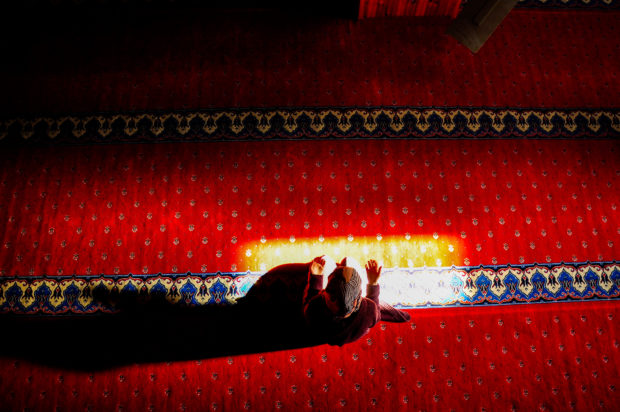
Soulieyman delivered a brief sermon, less than 10 minutes long, and everyone rose from their seated position. The service was over, and now it was time to share a meal.
They shared kabobs and lentil soup with lamb, drank a pineapple-ginger juice popular in West Africa, and chatted about life. They hadn’t been able to meet the week prior due to a snowstorm, and a few of them commented on how pronounced the absence felt after just a week. After such a powerful, transcendental experience in the dark, it’s hard to imagine missing even one service. The engraving on their hearts was made a little deeper that evening.
Meeting the Shabbat Bride
As the sun set on Friday evening, the congregation at Stephen Wise Free Synagogue sat at least six feet apart from each other, indicating a sign of the pandemic that’s engulfed the world for the past two years. The service began with six songs led by Cantor Daniel Singer, from the Kabbalat Shabbat, one to symbolize each day of the preceding week leading up to this service.
As the songs continued, everyone in attendance remained standing, facing the front of the Synagogue, where the Torah rests and the Cantor stands. Some participants clap to the beat of the song. Others gently rock back and forth. Some do a combination of both. Each song flows from one into another, with no break. The melodies merge from one to the next, with Cantor Singer saying which page to turn to in between the first verse of the songs.
On the seventh song, the service changes unexpectedly and without warning.
With no prompting from the cantor, everyone silently turns towards the back of the synagogue before they start singing, with no prompting from the Cantor. They all know what to do. Next steps and movements are all ingrained, as they slowly turn around while singing. The flow of the service up until this point could be analogized with the beginning of a traditional Western wedding. There is a prelude of songs, where everyone faces the front, and then when it is time for the bride to make her grand entrance, the crowd faces her. Each person smiles as they sing the seventh song, welcoming the long-awaited day of rest as if it were a young woman walking down the aisle.
Instead of focusing on the memorial plaques on the rear wall, all eyes are on the main door of the synagogue. For the remainder of the song, the door is the main focus. The clapping and rhythmic movement ceases, as they usher in the true beginning of Shabbat.
A small red light turns on next to some names on the memorial back wall. The lights symbolize an anniversary of death. But, death is not the focus in this ritual. Instead, the focus is the ultimate symbol of love and life, marriage.
In this case, the bride is the Shabbos everyone is welcoming. The lyrics of the song translate in English to, “Beloved, come to meet the bride; beloved come to great Shabbat.”
Singer explained that this tradition comes from the Jewish Mystical tradition, the Kabbalah. Welcoming Shabbat as a bride, he said, “is a metaphor for the time of redemption.” The Hebrew, “Boi Kallah,” means “come my beloved.” One day, the goal is to reach a day when the Messiah will come, and everyone will be peace.
“We pray for a day when we’ll be able to have Shabbat rest all the time,” Singer said.
A Prayer By Our Father, For His People
A man with a handheld microphone stands at the front of the room. Behind him, the wall is cast with lilac lights. He’s Taylor Figgins, the community life coordinator at Hope West Side, a church located on 86th Street and Central Park West.
“Let’s stand and pray the Lord's Prayer together,” he says in a soft voice.
The room of about 25 people shifts and every single person stands to recite the prayer. The creaking of chairs and brushing of coats and bags echo in the room as they do this. Some lift their bibles or their notebooks from their laps with them. Once standing they turn and lean down to place the books on the seats behind them. They bow their heads and close their eyes. Many clasp their hands together, while others open their arms out in front of themselves to “open themselves up to Jesus.” There are two screens at the front of the congregation, one on each side of the room. The words to The Lord’s Prayer appear on each one. The crowd recites it quietly in unison, some from memory and some reading off the screens.
Hope West Side is a progressive Evangelical Church established in 2018. The churchgoers recite the Lord’s Prayer at the same moment at every service: right before the sermon.
“We pray the Lord’s Prayer as a way to connect our Hope West Side church community to the generations of believers who have prayed this prayer since the beginning of the early church,” said Park.
“Our Father in heaven,
hallowed be your name,
your kingdom come,
your will be done,
on earth as it is in heaven.
Give us today our daily bread.
And forgive us our debts,
as we also have forgiven our debtors.
And lead us not into temptation,
but deliver us from the evil one.”
“For Yours is the kingdom and the power and the glory forever. Amen.”
Figgins says each phrase gently, taking time to pause in between each one. As they recite the prayer, one word is louder than all the rest. Everyone says Amen with certainty. This closes out the prayer and they all sit down to listen to the pastor’s prepared sermon.
This prayer is from the New Testament in Matthew 6:9-13. In this passage, Jesus explains to the disciples how they should pray, and recites this prayer as an example. The last line comes from newer versions of the bible and church tradition, whereas the rest is from the ancient text.
“It gives us a template for how Jesus wants us to pray,” says Pastor Mike Park, who sits in the front row. He says the prayer with his head bowed. “We could also say it’s the prayer that is formulated by God for us, while most of our prayers are formulated by us for God.”
He views this prayer as a point of connection between all Christian denominations.
“It’s also one of the oldest recorded Christian prayers and is common to the different streams of Christian faith: Protestant, Orthodox, Catholic,” Park says. “So it’s one of the prayers that we can usually pray together regardless of church background or tradition.”
For some believers, the prayer serves as a point of connection between themselves and God, one that they feel can and should be made often.
“There are many seasons where I will pray the Lord’s Prayer slowly several times a day, pausing at each line to think through the truth of that part of the prayer,” says Park.


